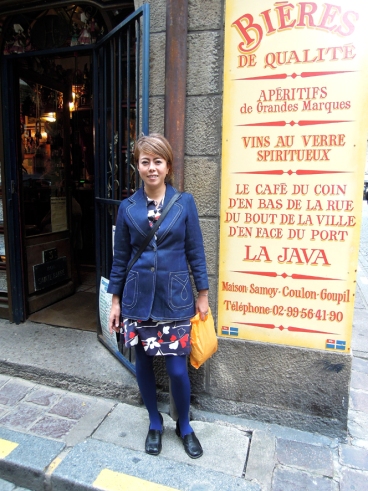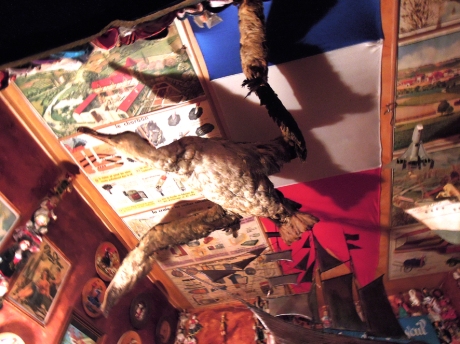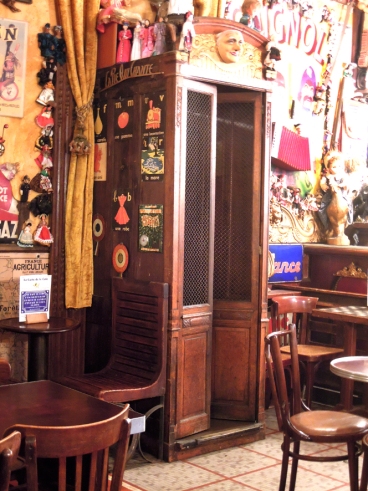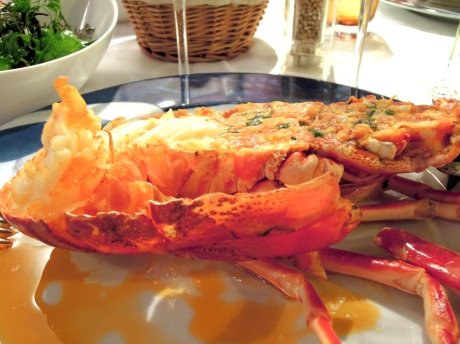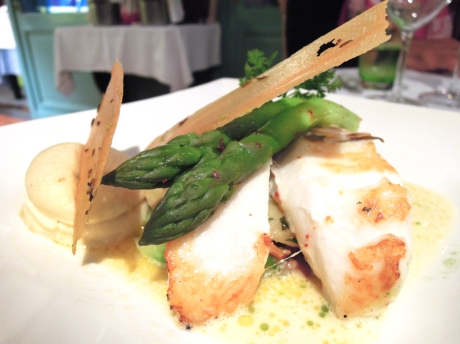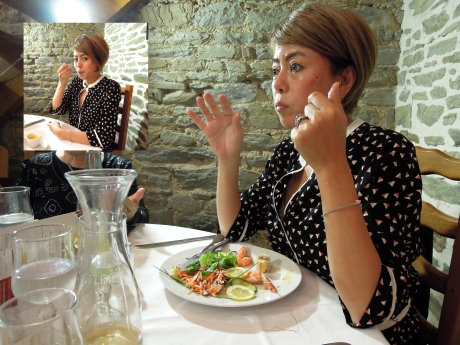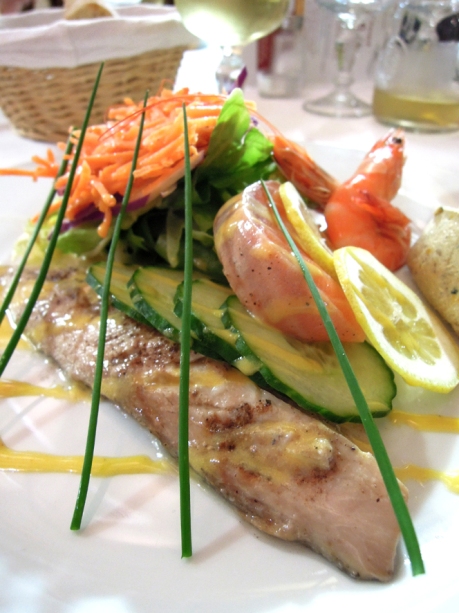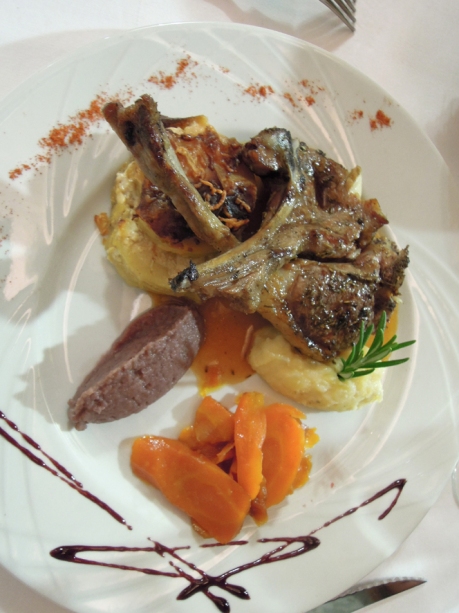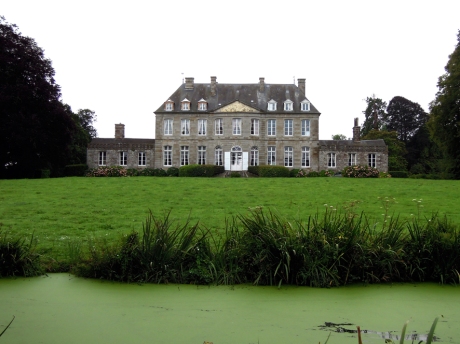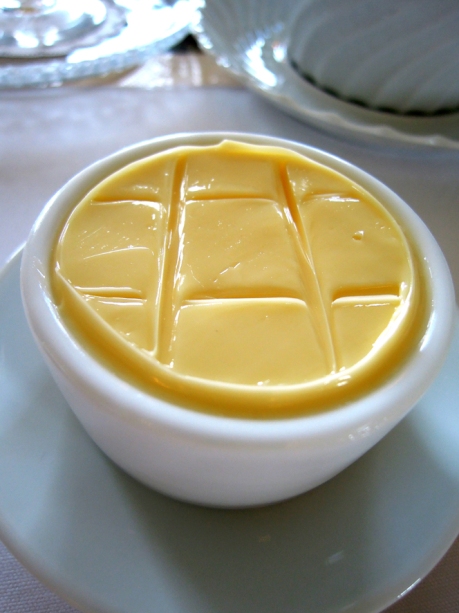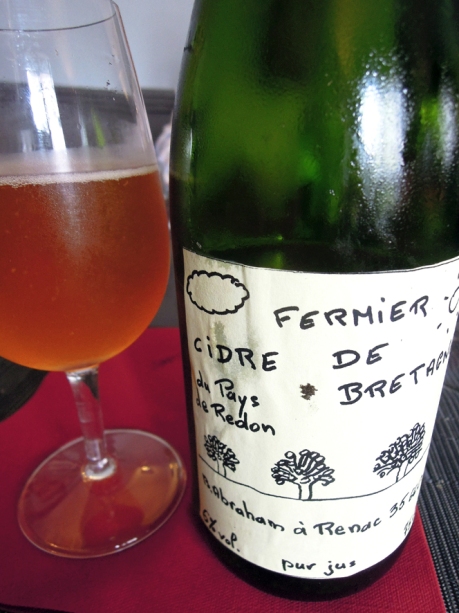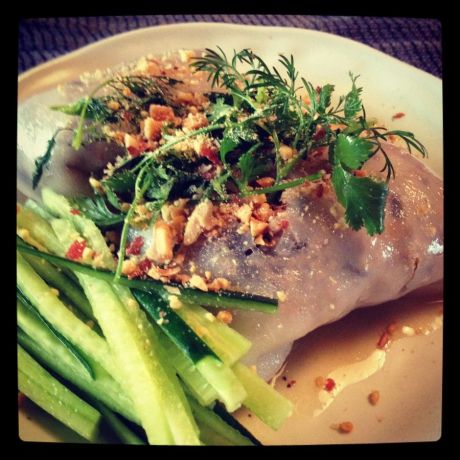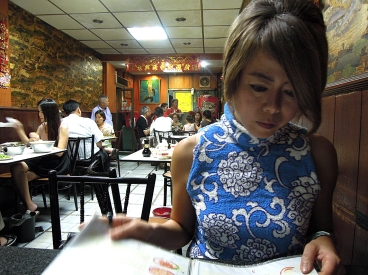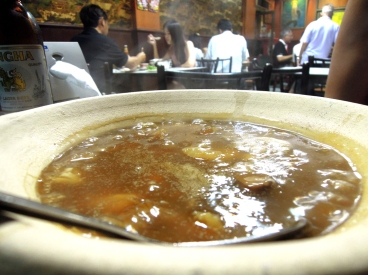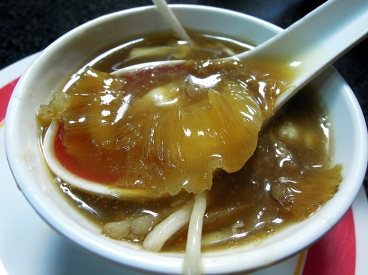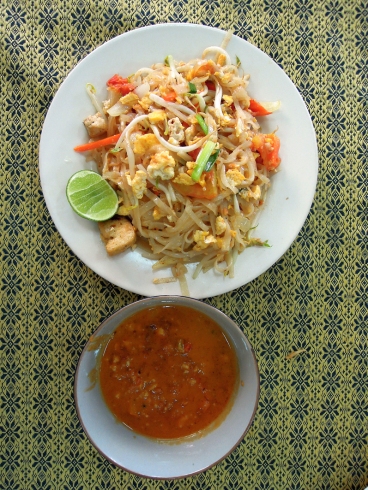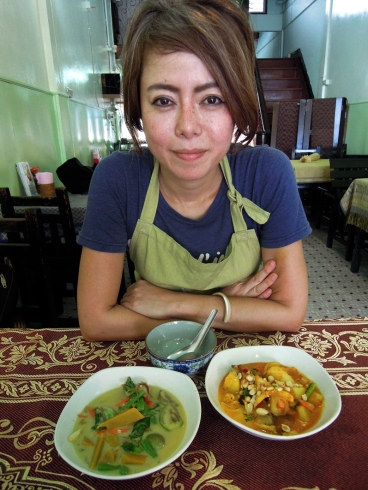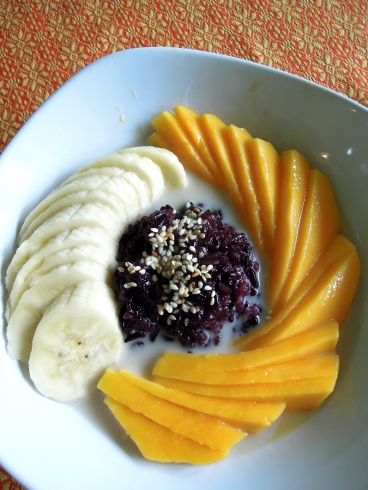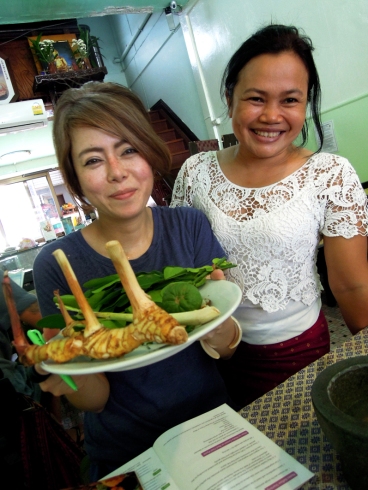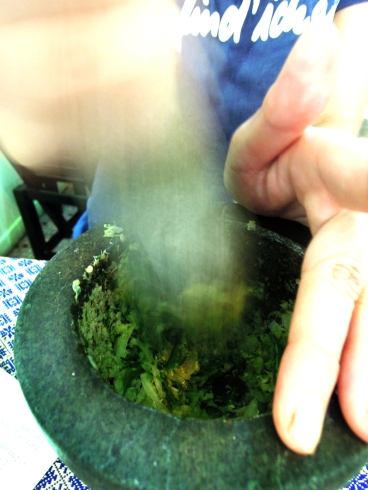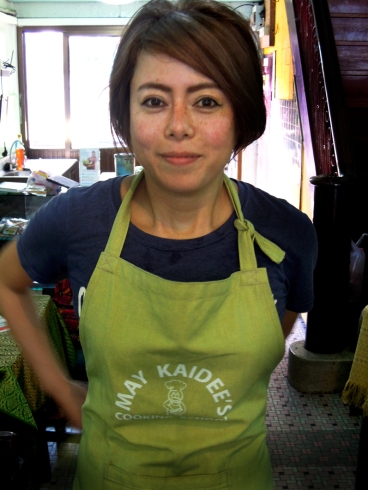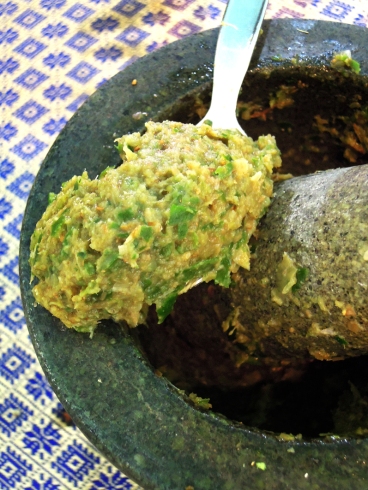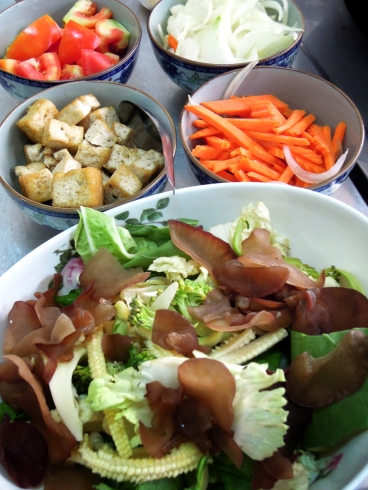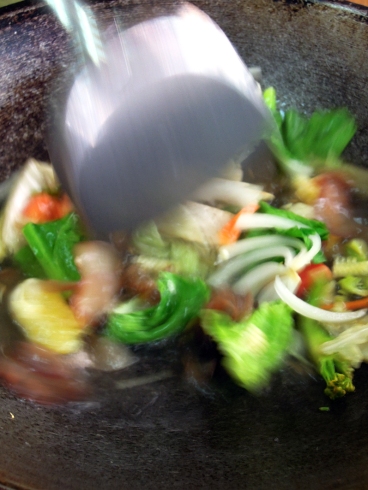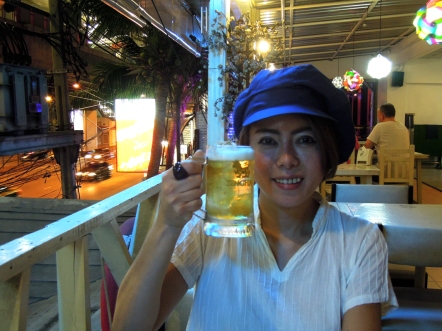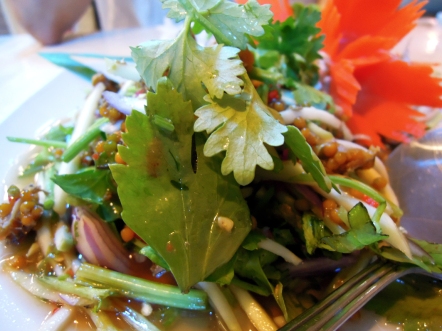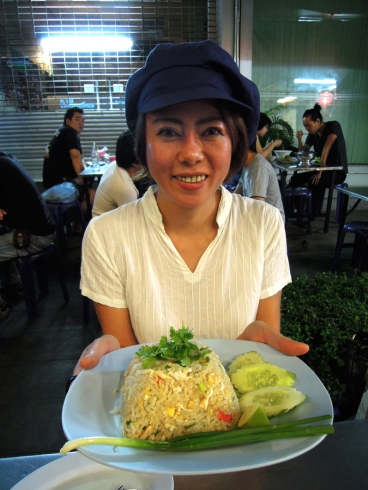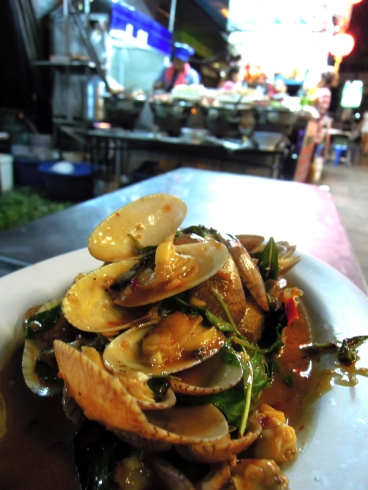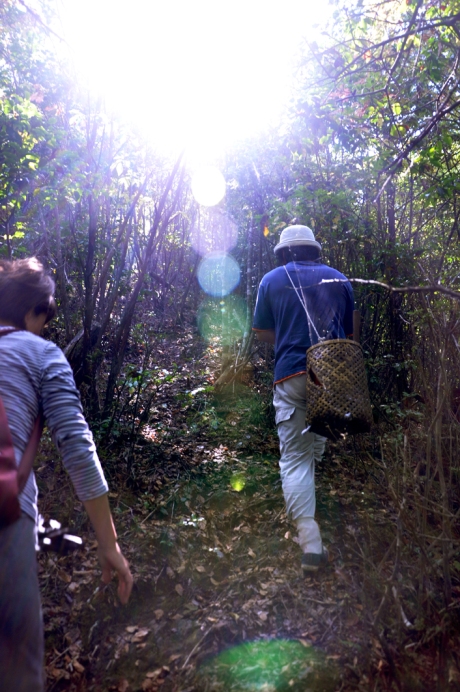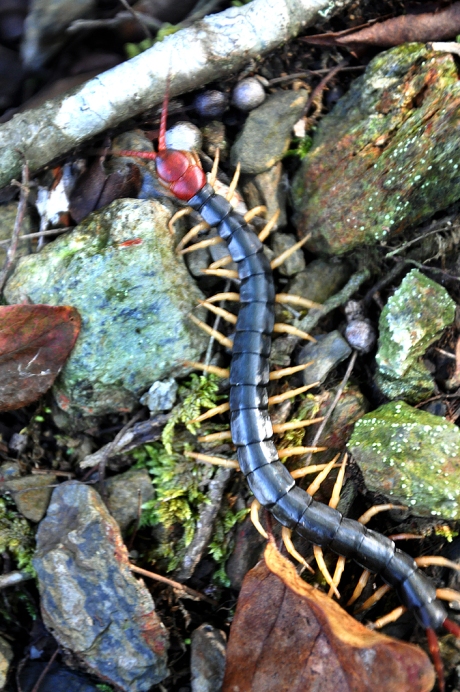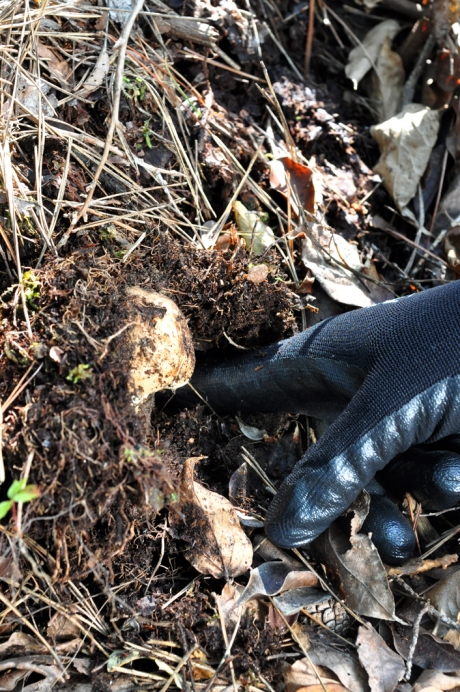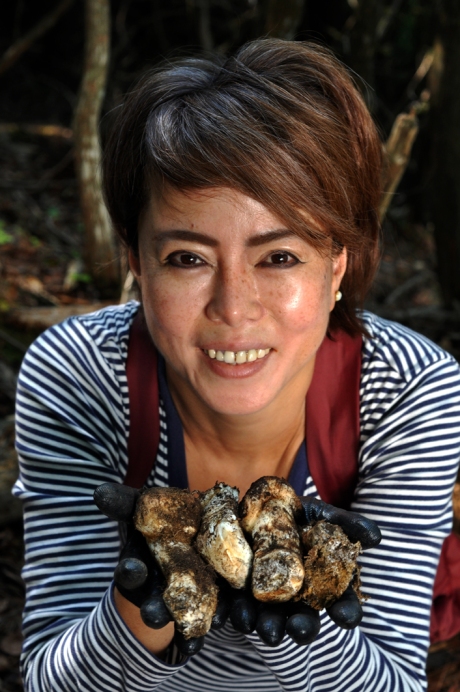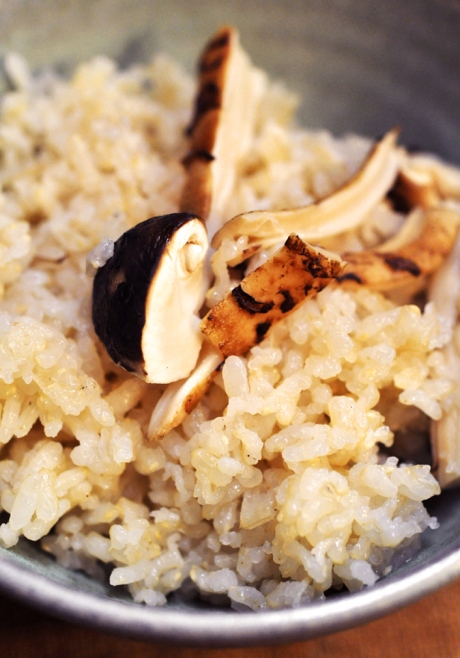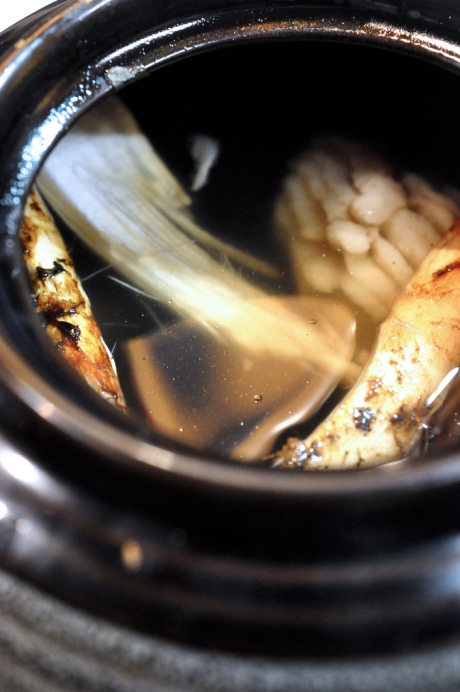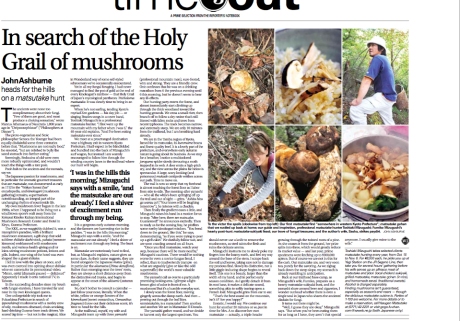先月、連れ合いのシンガポール航空機内誌、Silver Krisの取材にお供して、北陸の3つの温泉旅館に愛車で出向きました。Last month I drove up to Hokuriku in our beloved old car. I went to three very special hot-spring ryokan inns, helping out my partner with interviews for a magazine story (you can read his article in the Singapore Airlines Silver Kris in-flight magazine in Jan/Feb, if you wish).

これが、今回立ち寄った場所のマップです。まずは夏に行ってから心奪われた福井県の越前市にある若竹食堂で昼食を。Here is a map of our trip. Let’s start with the lunch we had at Wakatake Shokudo, in Echizen city, Fukui prefecture, a rustic but very tasty spot we stumbled across this summer and really like.

老夫婦できりもりされてるこのお店、昔から何一つ変わってないような町並みの中にひっそりと有ります。大ファンになったこの中華そばは、凡庸ながら、昔ながらの…としか形容出来ない味です。鶏ガラと野菜で取ったであろうかと思われるこの澄んだスープは、ラーメンとは全く違うものだと思わせます。地元の人にしっかり根付いたこの名店の主は、新参者の私たちの事を覚えていてくれていました。This small noodle shop is located in a rural townscape that hasn’t changed at all for quite some time. The Chuka Soba (trad Japanese approach to Ramen) they serve is what I can only describe as ‘good old time’ chuka soba. I can guess that they use chicken bones and a blend of vegetable for this wonderful broth. This is what makes me feel this is a totally different from Ramen.This shop is so well loved by locals, but the owner remembered that this is our 2nd visit. I guess we stood out a bit.
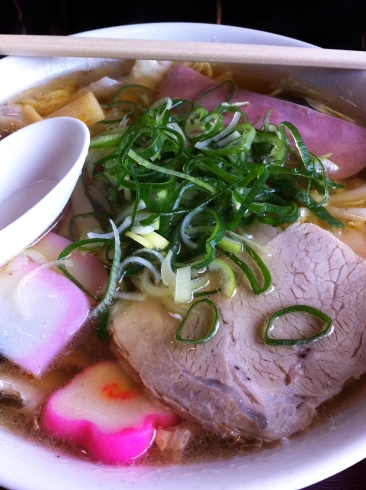
さて、一泊目の取材地の加賀、山城温泉郷のべにや無何有に到着です。通された部屋の広大な窓からは、丁度色づきかけた紅葉が一望出来ます。ハッと息を呑むような景色です。This was our first onsen ryokan of the trip, Beniya Mukayu. Our room had a huge window so you could see all these leaves which had just started to change colour. It was breathtakingly beautiful!

勿論大きなお風呂も設備されていますが、贅沢な事に全てのお部屋にこのようなプライベートの露天風呂が付いています。先ほどの景色がここからも目の前に広がっています。There are bigger open-air baths in the hotel, but each room has one of these private open-air baths as well. You can view the beautiful mountain leaves from your own bath.

夕食の取材に入ります。全てご紹介したいのですがここでは特に気に入ったものを何点か。これはセイコ蟹。香箱蟹またはコッぺ蟹とも言い、地域で色々な呼び方があるらしいです。旬は11月から年末迄と限られていて、幸運にも今回テーブルに上がりました。盛りつけの演出が美しいのはさることながら、やはり味も最高です。特にこの朱色の内子と呼ばれる部分はまったりとクリーミーでこの上なく美味です。We interviewed the owner about the dinner course for the magazine. I wish I could introduce every dish here, but there were too many! Let me write about my favorites from that night. This crab is called seikogani, koubakogani or koppegani; it has various local names. Its English name is, I think, the Snow Crab. The peak season lasts only 2 months from November to the end of December, and we were lucky with our timing. Look how beautifully it was prepared and served. But not only that, the taste was wonderful, especially the bright orange uchiko, literally the ‘inside egg’. It was so creamy.
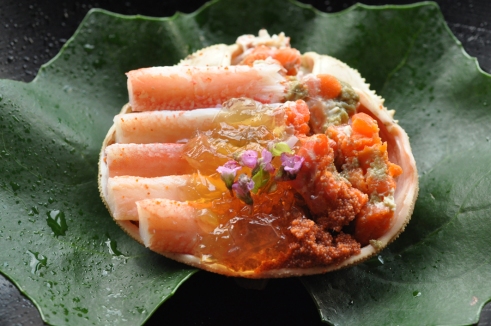
冬の味覚の王様、越前蟹。美しい木箱で蒸された状態で出て来ました。茹でないので蟹のうまみがどこへも逃げません。木の香りがほのかに移ってその匂いさえごちそうの一部です。This, below, is the king of the winter taste palate, Echizen-gani crab. It was steamed in a beautiful, specifically crafted wooden box. As it isn’t boiled, the complete taste of the crab is retained, and there is a very delicate hint of the wood aroma in the crab itself. This is all part of the food celebration that Beniya Mukayu provides.
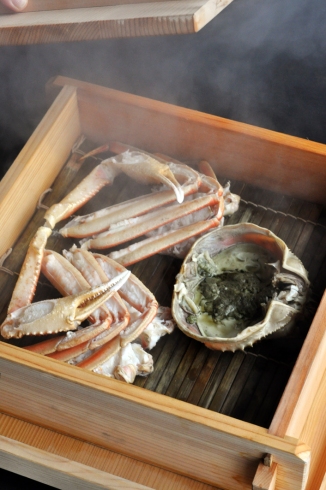
一貫ずつ出されたお寿司。これ以上は望めない新らしさのアオリイカとマグロ。お皿は何と江戸時代のものらしいです。This sushi was served just like this. It couldn’t be fresher, consisting of aori ika squid and tuna sourced from the nearby sea. The dish upon which it is served dates back to the Edo period.

特筆すべきは朝食の素晴らしさでしょうか。この肉厚のたらこは釣りたらこと呼ぶそうです。縄を海中に垂らして捕るこの昔ながらの方法は、網で捕る方法よりずっと手間が要り効率も劣りますが、魚体を傷つけないのでより新鮮な卵を確保出来ます。炭火で焼きます….1粒1粒の際立った味で御飯が際限なくいけそうです。Mukayu’s breakfast is something special. This meaty cod roe is called tsuri tarako; the cod is fished by line rather than in a net, so it is caught with the roe undamaged. It demands to be eaten with mountains of rice, ad infinitum!
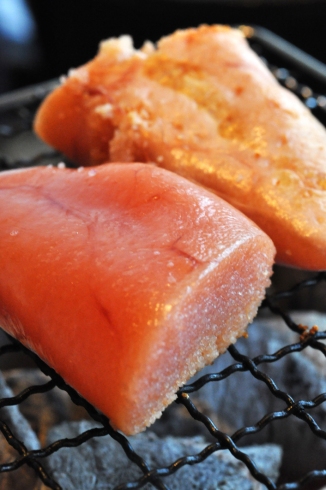
またしても最強の御飯の友、京都でもお馴染みのちりめん山椒。This too is the perfect accompaniment to rice. It is chirimen zansho, dried baby anchovies with Szechuan pepper, a Kyoto favorite.

他では和朝食が大半の中で、ここは洋のブレークファストも充実していますね。ふっくらしたオムレツと、ベーコンとチーズ Most onsen ryokan serve only Japanese breakfasts. At Mukayu they offer a very good western breakfast too, with a fluffy omelette, bacon and cheese.
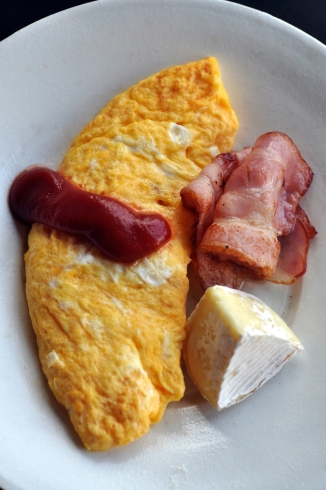
和朝食のメインの湯豆腐の出し方。特注の木桶の湯の中で豆腐も気持ち良さげにぷかぷか。暖めた豆乳に出汁醤油を少し入れたものにくぐらせて食べるユニークなものです。優しく体も喜ぶ味。手前の3つのグラスは目の前で搾って供されるオーガニックの野菜ジュース。真ん中の緑色の青じそジュースが特に美味!!目がシャッキリと覚めて来ます。This, below, is how they serve the main Japanese breakfast course. The tofu happily bubbles away in the custom-made wooden server. It is a unique way of eating yudofu. Here warmed soy milk is added to the soy dipping sauce. It is good for you and tasty. The three glasses at the front are fresh, organic juices, and they are great! The middle one, shiso perilla juice, is especially good. It wakes you up on a sleepy morning.

次の日は足を伸ばして富山市のリヴァーリトリート雅樂倶へ。神通川のほとりにあるモダーンなホテルです。The next day we headed to Toyama city, and River Retreat Garaku, a modernist, art-filled onsen ryokan set by the Jintsugawa River.

エントランス後方にある広いロビー。The lobby is a large, luxurious space. Cool, isn’t it?

昨日は温泉から加賀の色付くを木々を望んで、今日は神通川が一望出来ます。Yesterday we enjoyed the beautiful autumn foliage. Today we could watch the mountains from the bath.

ホテル内の日本料理店、樂味は京都の人気店、祇園さゝ木で20年包丁を握って来た木田さんが料理長を務めています。At the Japanese restaurant inside the hotel, ‘Rakumi’, Kida-san is the master chef. He studied at Kyoto’s famed Michelin-starred Gion Sasaki for 20 years.
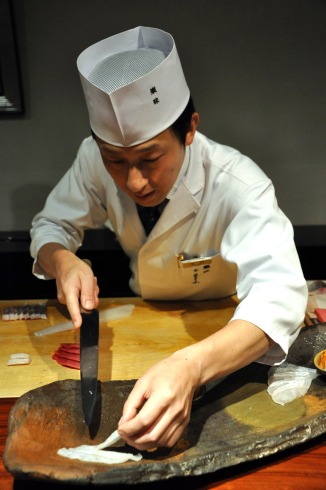
祇園さゝ木の源流ともいえる盛りつけを、力強くも繊細に… This is the celebrated ‘Gion Sasaki’ style of presentation, bold and sensitive at the same time.

最高級の大間マグロの寿司は初めて食べました。本当に口の中でとろけていきます。この刷毛で特製の醤油を塗るのも、祇園さゝ木のオリジナルですね。これ以外にも氷見ぶりのお刺身などにもうなってしまいました。It was the first time I ate Ooma maguro (the finest of all tuna). It truly melts in your mouth. Again, brushing the special soy sauce on to the sashimi is a Gion Sasaki trademark. The local Himi Buri yellowtail was also fantastic.
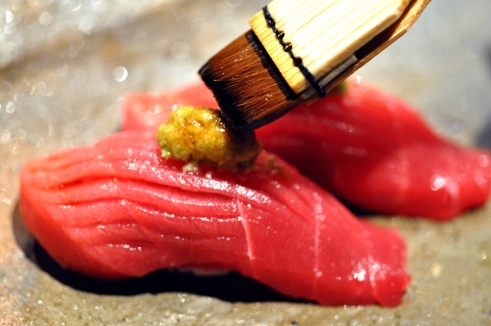
おいしいものを食べると人は時に放心状態になります… People clearly lose the ability to think when eating something truly delicious.
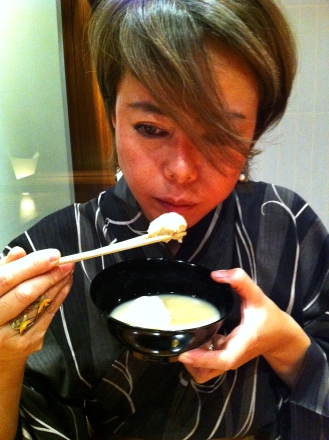
地元の名酒立山純米吟醸(記憶が正しければ)を冷やで。あしらいの紅葉を浮かべてみました。This is one of the local sake offerings, Tateyama. A junmai ginjo, if memory serves.

フレンチのレストランは、西洋膳所サヴールと言います。ワインの種類がとても豊富で、自産自消の材料を使った、洗練されたヌーベルキュイジーヌが頂けます。The hotel’s French restaurant is called ‘Saveur’. Its wine cellar is huge and impressive, its menu a sophisticated nouvelle cuisine utilising local ingredients, combined with truffles, fois gras etc.
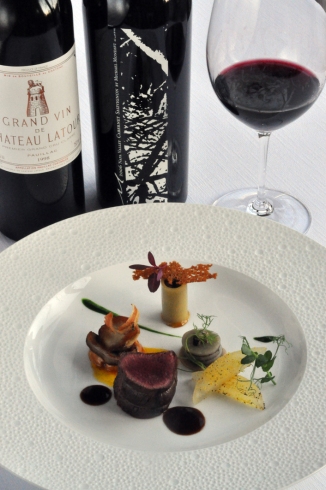
この日のメインは子鹿の赤ワイン煮です。トリュフとファグラと共に。This was one highlight, wine-simmered venison.

さて、最終目的地である奥能登半島を目指して富山を後にします。とある道の駅でかねてから食べてみたかった富山湾の宝石、白海老を使った白海老バーガーを発見!ランチ代わりに即購入!お味は?And so the next day, we headed off to Oku-Noto, and the ryokan Ranpu no Yado at the remote Northernmost point of the Noto Peninsula. On the way we stopped off at a highway service station to sample something I have always wanted to eat, the Toyama-only shiroebi white shrimp burger.

………..ん?何か油切れが悪い?それに油が古い感じ… And how did it taste? Aargh. Oily. And the oil smelled bad. But I ate it anyway.
はい。この白海老バーガーを食べた6時間後から前代未聞級の食あたりになってしまいました!やはり、あの油が悪かったのだと思います。そんな訳で以下は私が、その晩病に伏した為食す事の出来なかった数々ゴージャスな能登の郷土料理の一部です。トホホ… まずは、大きな鮑の焼き物。Six hours later I regretted my decision. The bout of food poisoning was the worst I have ever experienced. I shall spare you the gruesome details, but let’s say that oil was indeed very old. Thus, I could eat any of the gorgeous dinner dishes, two of which are shown here below. Aaah…
This was a particularly huge grilled abalone.
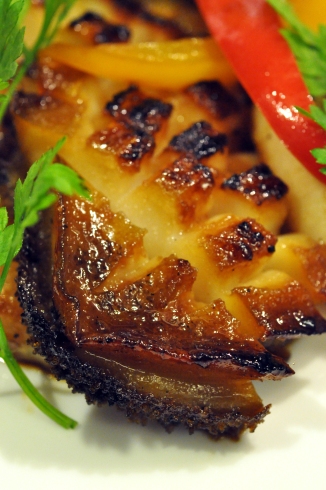
セイコ蟹、香箱蟹。ここではコベッコ蟹と呼ばれます。花びらのようなものは大根を手で細工したものです。This is the Hokuriku seasonal star, seiko-gani/kobekko-gani. The petal motif is, in fact, hand-crafted and coloured daikon giant radish.
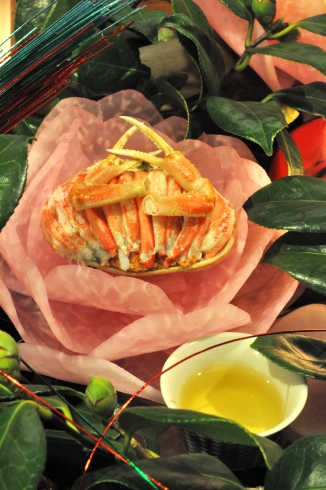
具合が悪くなる直前に入った、この『ランプの宿』自慢の絶景露天風呂。この日は波浪注意報が出ていた程目の前の日本海は荒れ狂っていました。海に突き出た造りのこのお風呂は、窓も仕切りも無いので時折しぶきがかかる程です!少し怖い程ですが、何故か飽かずにずっと眺めている事が出来ます。
The photo below is me just before I became horribly ill. It is Ranpu no Yado’s spectacular rotemburo outdoor bath. That day there was a ‘rough seas warning’ in place, and the Japan Sea, right in front of the bath, was raging. There’s no protection from the elements here, and you can feel the sea spray as you bathe, inches away from the waves. It was a little scary, but it’s a hypnotic experience. You can stare at the sea for hours on end.
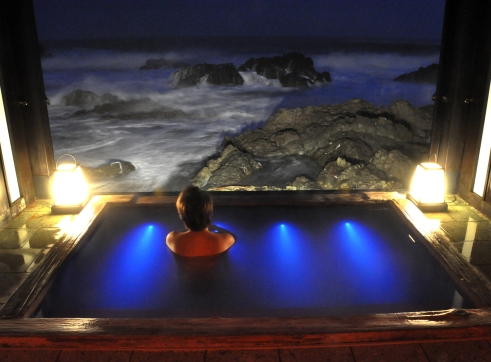
しかし!お宿のお料理も全ては見過ごしませんでした!!次の日の朝食には、まだ少し弱っておりましたが少しなら食べられる程迄回復し。ひと塩したかますの干物と… Food poisoning or no, all was not lost! By breakfast time, I had just about recovered enough to eat a little bit. This was the grilled local over-night salted kamasu barracuda-fish.
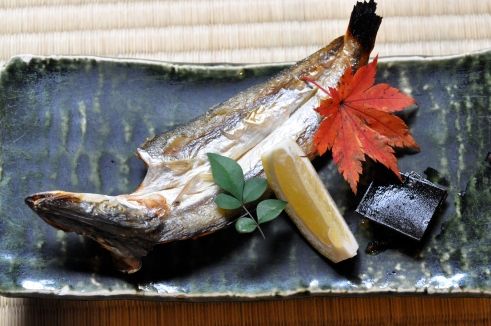
地元の牧場のミルクを使った手作りブルーベリーヨーグルトなどはしみじみ美味しく体に染み渡りました。But, best of all… home-made blueberry yoghurt from a local farm, delivered by the farmer himself. Just what my recently-poisoned internal organs needed!
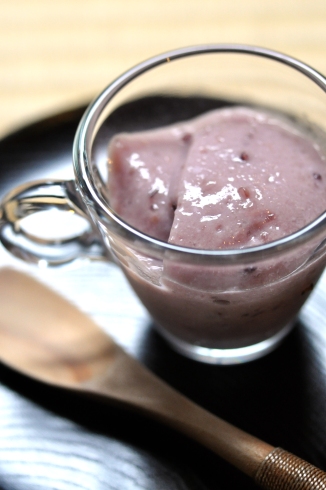
晩秋の北陸は暖かい人々と美味しいものの宝庫でした。アクシデントはありながらも、また行きたいと思いました。I met some lovely kind people up in Hokuriku, and ate some lovely food. There was the minor poisoning incident, but… I want to go back!
35.025757
135.775329

